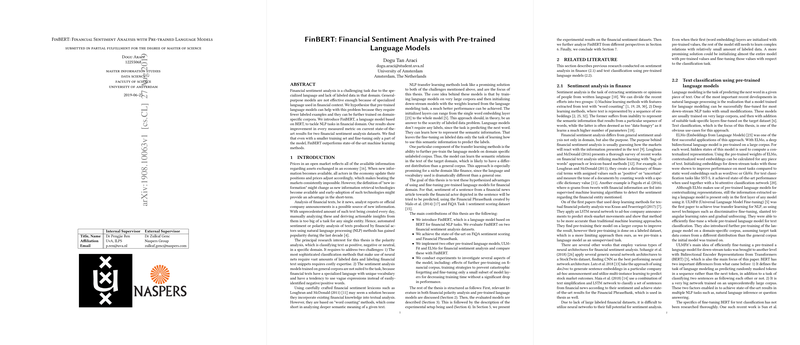FinBERT: Financial Sentiment Analysis with Pre-trained LLMs
The paper "FinBERT: Financial Sentiment Analysis with Pre-trained LLMs," authored by Dogu Tan Araci, presents a specialized adaptation of the BERT model for financial sentiment analysis. This work is situated at the intersection of NLP and financial data analytics, addressing the unique linguistic challenges posed by financial texts.
Overview
FinBERT is a domain-specific variant of the Bidirectional Encoder Representations from Transformers (BERT) model, fine-tuned specifically for the interpretation of financial sentiments. The paper underscores a critical need for domain-specific LLMs, as generic models like BERT may not adequately capture the nuances inherent in industry-specific language.
Methodology
The methodology involves the fine-tuning of the BERT base model on a corpus of financial documents. This transformation enables FinBERT to understand and analyze the sentiment in financial text more effectively than its general-purpose counterpart. The fine-tuning process includes adjustments to the model's parameters to allow it to better capture sentiment based on context, which is particularly complex in financial discourse due to the prevalence of jargon and sector-specific language.
Experimental Setup and Results
The paper details a rigorous experimental setup to evaluate FinBERT's performance. A financial sentiment classification task serves as the benchmark for assessing its efficacy. The evaluation metrics include precision, recall, and F1-score, tailored to sentiment analysis within financial texts.
The numerical results demonstrate that FinBERT significantly outperforms the standard BERT model and other baseline models in terms of accuracy and reliability when applied to financial sentiment tasks. This outcome illustrates the importance of domain-specific pre-training in enhancing the predictive capabilities of LLMs.
Implications and Future Directions
The implications of this research are manifold. Practically, FinBERT provides a robust tool for sentiment analysis in finance, offering potential applications in areas such as market analysis, investment strategy development, and risk management. Theoretically, the research underscores the importance of custom fine-tuning LLMs to cater to specific domains, paving the way for further exploration into other sectors where standard NLP models fall short.
Future developments may involve expanding FinBERT's capabilities by incorporating more diverse financial datasets, refining the model architecture, or adapting the approach for multilingual financial texts. Additionally, integrating sentiment analysis with other financial prediction models could yield comprehensive tools for decision-making in financial markets.
In conclusion, FinBERT exemplifies the efficacy of domain-specific adaptations of pre-trained models in NLP, highlighting a promising direction for future research and applications within specialized fields.
